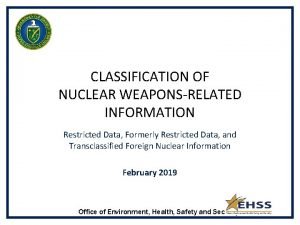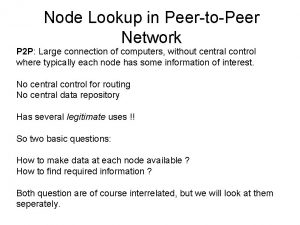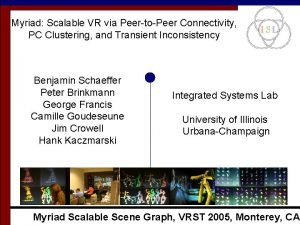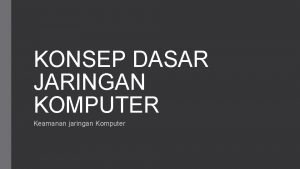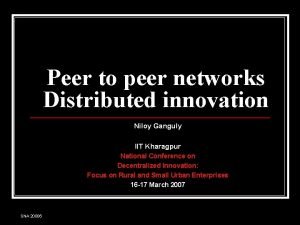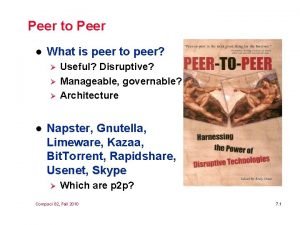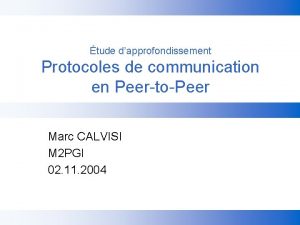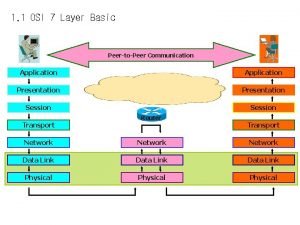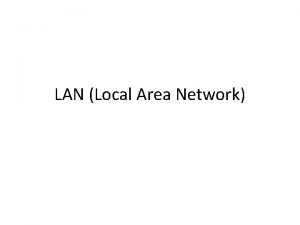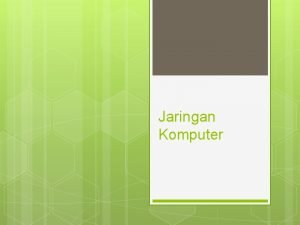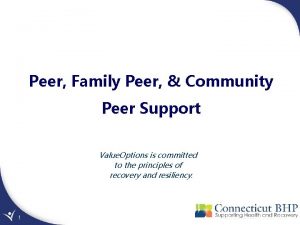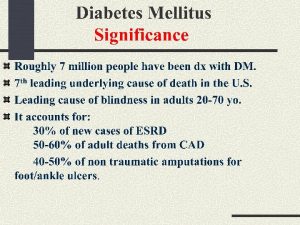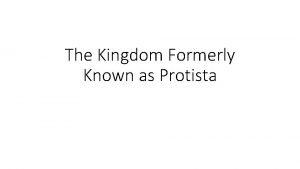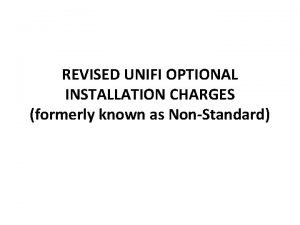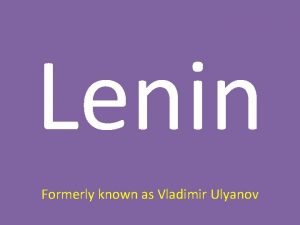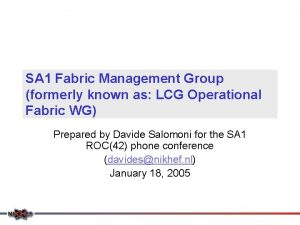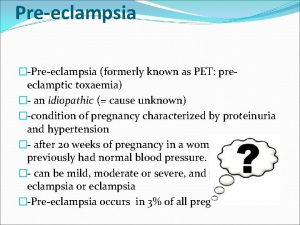Peer 2 Peer Support is formerly known as
























- Slides: 24

Peer 2 Peer Support is formerly known as STAIT Dr. Babatunde Osotimehin Under Secretary General and Executive Director of UNFPA Peter Lundberg Deputy Humanitarian Coordinator, Nigeria Ingrid Macdonald Director, P 2 P Support WEBINAR FACILITATOR P 2 P Support – For Humanitarian Leaders in the Field Created by the Emergency Directors’ Group (EDG) in 2013

Peer 2 Peer Support is formerly known as STAIT Why is collective leadership by the HC and HCT critical for ensuring effective response to Gender Based Violence in field operations? P 2 P Support – For Humanitarian Leaders in the Field Created by the Emergency Directors’ Group (EDG) in 2013

Peer 2 Peer Support is formerly known as STAIT Why is collective leadership by the HC and HCT important? Dr. Babatunde Osotimehin Under Secretary General and Executive Director of UNFPA • GBV is not just technical – it requires SENIOR leadership • GBV is not only a one agency/sub-cluster issue – it requires everyone to work together at all levels on: • • Prevention and mitigating risks Ensuring that survivors have access to life-saving care. • SGBV is one of the four mandatory priorities of the new HCT TORs • GBV is a part of the IASC Principals commitment to the Centrality of Protection in Humanitarian Action – a core responsibility of HC/HCTs. • GBV is a life-saving criteria for CERF proposals. P 2 P Support – For Humanitarian Leaders in the Field Created by the Emergency Directors’ Group (EDG) in 2013

Peer 2 Peer Support is formerly known as STAIT Role of leadership: advocacy, visibility and accountability Dr. Babatunde Osotimehin Under Secretary General and Executive Director of UNFPA 1. Conduct ADVOCACY • Promote inclusion of GBV requirements in humanitarian appeals and donor initiatives • Promote agreed advocacy messages with high-level stakeholders 2. Give VISIBILITY to the issue • Have regular items on GBV priorities at HCT meetings • Ensure GBV is visible in response planning (HNO/HRP). 3. Promote mutual ACCOUNTABILITY • Include commitments to GBV prevention, mitigation and response in HCT compacts, strategies and work plans. P 2 P Support – For Humanitarian Leaders in the Field Created by the Emergency Directors’ Group (EDG) in 2013

Peer 2 Peer Support is formerly known as STAIT What can Humanitarian Coordinators and HCTs do to address popular misconceptions concerning GBV prevention and response? P 2 P Support – For Humanitarian Leaders in the Field Created by the Emergency Directors’ Group (EDG) in 2013

Peer 2 Peer Support is formerly known as STAIT Misconceptions on GBV and what HCs and HCTs can do Dr. Babatunde Osotimehin Under Secretary General and Executive Director of UNFPA Misconception Reality and Action 1. Data or “proof” that GBV is happening is necessary to justify response or funding. 1. Assume GBV is taking pace and support action to mitigate risk and reduce harm. 2. GBV is not a priority compared 2. Play a role in underscoring to other sectors. that GBV is life – saving. 3. GBV prevention and response 3. Underscore the need for all can only be done by GBV actors to treat GBV as life specialists. threatening and minimize GBV risk across all sectoral interventions. P 2 P Support – For Humanitarian Leaders in the Field Created by the Emergency Directors’ Group (EDG) in 2013

Peer 2 Peer Support is formerly known as STAIT As a Deputy Humanitarian Coordinator, what concrete steps have you and the HCT taken to address GBV across the response? P 2 P Support – For Humanitarian Leaders in the Field Created by the Emergency Directors’ Group (EDG) in 2013

Peer 2 Peer Support is formerly known as STAIT Prioritizing GBV in coordination and response Peter Lundberg Deputy Humanitarian Coordinator, Nigeria • From start: Recognised prevalence & risk of GBV • In L 3 scale up: Prioritised gender equality & response • Set-up: GBV sub-sector groups in 4 conflict affected states focused on coordination & operational support • Set up: Abuja (capital) GBV sub-sector group focused on policy and strategy • Ensured: Joint government co-leadership P 2 P Support – For Humanitarian Leaders in the Field Created by the Emergency Directors’ Group (EDG) in 2013

Peer 2 Peer Support is formerly known as STAIT Nigeria: Fostering collaborative efforts & approaches • Enhanced accountability – eg, police, judicial systems Peter Lundberg Deputy Humanitarian Coordinator, Nigeria • Prioritised joint UN, NGO & government life-saving interventions eg. GBV case management, material & clinical assistance • Strengthened community protection systems eg. Child networks • Integrated recovery within GBV response eg. Livelihood initiatives • Enhanced capacity of frontline service providers • Established and strengthened framework for PSEA P 2 P Support – For Humanitarian Leaders in the Field Created by the Emergency Directors’ Group (EDG) in 2013

Peer 2 Peer Support is formerly known as STAIT What steps have you taken to ensure that GBV is integrated across the different sectors? P 2 P Support – For Humanitarian Leaders in the Field Created by the Emergency Directors’ Group (EDG) in 2013

Peer 2 Peer Support is formerly known as STAIT Integrating GBV across response Peter Lundberg Deputy Humanitarian Coordinator, Nigeria • Implementation of GBV prevention and mitigation strategies, eg. Referral pathways & SOPs; • Built resilience through community based systems, eg. Community outreach and dialogue • Provided support to local and national capacity for lasting solutions P 2 P Support – For Humanitarian Leaders in the Field Created by the Emergency Directors’ Group (EDG) in 2013

Peer 2 Peer Support is formerly known as STAIT Practical steps for sectors • Appoint GBV focal points in sector groups Peter Lundberg Deputy Humanitarian Coordinator, Nigeria • Incorporate GBV within sector activities • Develop user-friendly, context appropriate GBV mainstreaming tools • Conduct GBV mainstreaming trainings with humanitarian staff P 2 P Support – For Humanitarian Leaders in the Field Created by the Emergency Directors’ Group (EDG) in 2013

Peer 2 Peer Support is formerly known as STAIT IN MEMORY Dr. Babatunde Osotimehin Under Secretary General and Executive Director of UNFPA P 2 P Support – For Humanitarian Leaders in the Field Created by the Emergency Directors’ Group (EDG) in 2013

Peer 2 Peer Support is formerly known as STAIT Kate Moger Deputy Regional Director for West Africa, IRC Neil Buhne Resident and Humanitarian Coordinator, Pakistan Ingrid Macdonald Director, P 2 P Support WEBINAR FACILITATOR P 2 P Support – For Humanitarian Leaders in the Field Created by the Emergency Directors’ Group (EDG) in 2013

Peer 2 Peer Support is formerly known as STAIT What steps has IRC taken to institutionalise GBV prevention and response globally and locally? How has it contributed to collective response? P 2 P Support – For Humanitarian Leaders in the Field Created by the Emergency Directors’ Group (EDG) in 2013

Peer 2 Peer Support is formerly known as STAIT IRC’s steps: internal policy & response • Provides GBV survivors with lifesaving services Kate Moger Deputy Regional Director for West Africa, IRC • Builds GBV sector capacity to enhance response when crisis hits • Prioritises gender and GBV in institutional policies o Gender equality commitment in new IRC strategy o Outcomes and evidence framework aims to reduce the gender gap o Gender and GBV prioritised in country strategies Ex. 6/8 countries in West Africa, Sahel and Central Africa prioritize GBV in strategies P 2 P Support – For Humanitarian Leaders in the Field Created by the Emergency Directors’ Group (EDG) in 2013

Peer 2 Peer Support is formerly known as STAIT IRC’s steps: Global advocacy • Ensure GBV is prioritised in the global advocacy agenda Kate Moger Deputy Regional Director for West Africa, IRC ü Call to Action on protection from GBV in Emergencies: global platform of 66 partners ü Seek dedicated commitments on women and girls in global processes, eg. GBV is a core commitment of the World Humanitarian Summit. • BUT: Must ensure that high level commitments result in concrete change for women, girls and GBV survivors P 2 P Support – For Humanitarian Leaders in the Field Created by the Emergency Directors’ Group (EDG) in 2013

Peer 2 Peer Support is formerly known as STAIT What can NGO country representatives do to prioritize GBV prevention and response across collective humanitarian efforts? P 2 P Support – For Humanitarian Leaders in the Field Created by the Emergency Directors’ Group (EDG) in 2013

Peer 2 Peer Support is formerly known as STAIT Prioritize GBV across collective efforts Kate Moger Deputy Regional Director for West Africa, IRC Advocate to ensure humanitarian leadership is accountable for implementing current commitments: § Call to Action on Protection from GBV in Emergencies § Real-Time Accountability Partnership eg. Include commitments to GBV prevention, mitigation and response in the HCERC Compact. § GBV coordination bodies in field and globally used for advocacy eg. Cameroon HCT selected GBV as a key protection issue in their strategy - Implement existing minimum standards for reducing the risks of GBV in emergencies: § Support roll-out of the updated IASC GBV Guidelines P 2 P Support – For Humanitarian Leaders in the Field Created by the Emergency Directors’ Group (EDG) in 2013

Peer 2 Peer Support is formerly known as STAIT What steps have you and the Humanitarian Country Team taken in Pakistan to prioritise GBV prevention, response and mitigation? P 2 P Support – For Humanitarian Leaders in the Field Created by the Emergency Directors’ Group (EDG) in 2013

Peer 2 Peer Support is formerly known as STAIT HC & HCT leadership on GBV • Advocacy / visibility / accountability Neil Buhne Resident and Humanitarian Coordinator, Pakistan ü HSP has a GBV section since 2014 ü Linking clusters in preventing, mitigating and referral of GBV cases ü Gender & GBV training by all clusters ü Including female staff & mandatory 30% female mission members strengthens disaggregated data & assessment, analysis & response to GBV survivors & women ü Collaboration with the NDMA (government) Gender and Child Cell ü Interagency and civil society forum of GHTF highlight GBV concerns ü Donor briefs raise GBV concerns P 2 P Support – For Humanitarian Leaders in the Field Created by the Emergency Directors’ Group (EDG) in 2013

Peer 2 Peer Support is formerly known as STAIT What lessons could be helpful for other operations, including addressing cultural challenges? P 2 P Support – For Humanitarian Leaders in the Field Created by the Emergency Directors’ Group (EDG) in 2013

Peer 2 Peer Support is formerly known as STAIT Way Forward in GBV mitigation Neil Buhne Resident and Humanitarian Coordinator, Pakistan Contextualize: – Respect local tradition, norms and values – Collect location specific data Advocate and adapt implementation: – Mix hard and soft activities in culturally sensitive and appropriate manner – Look for opportunities in every plan, budget, mission, and action to prioritise GBV – Build sustainability through local committees where men and women define their own protection and empowerment solutions P 2 P Support – For Humanitarian Leaders in the Field Created by the Emergency Directors’ Group (EDG) in 2013

Peer 2 Peer Support is formerly known as STAIT Way Forward in GBV mitigation Neil Buhne Resident and Humanitarian Coordinator, Pakistan – Support diverse coordination networks – Build quantitative & qualitative assessment capacity for GBV analysis, adapted activities and monitoring – Ensure male and female staff balance – Utilise the humanitarian development SGBV risks & vulnerabilities continuum to capture good practices cannot be understood only with and address problems in transition quantitative analysis- we also programming need qualitative data analysis P 2 P Support – For Humanitarian Leaders in the Field Created by the Emergency Directors’ Group (EDG) in 2013
 Bank alfalah formerly
Bank alfalah formerly Sxole
Sxole Formerly restricted data
Formerly restricted data Absence management formerly aesop
Absence management formerly aesop Node lookup in peer to peer network
Node lookup in peer to peer network Relazione finale tutor tirocinio esempio
Relazione finale tutor tirocinio esempio Peer-to-peer o que é
Peer-to-peer o que é Annotazioni sulla verifica effettuata peer to peer
Annotazioni sulla verifica effettuata peer to peer Programmazione e sviluppo condiviso peer to peer
Programmazione e sviluppo condiviso peer to peer Cons of skype
Cons of skype Gambar topologi peer to peer
Gambar topologi peer to peer Peer-to-peer o que é
Peer-to-peer o que é Peer to peer l
Peer to peer l Peer-to-peer o que é
Peer-to-peer o que é Peer-to-peer
Peer-to-peer Peer-to-peer communication in osi model
Peer-to-peer communication in osi model Jaringan peer to peer diistilahkan dengan
Jaringan peer to peer diistilahkan dengan Esempi di peer to peer compilati
Esempi di peer to peer compilati Peer to peer computing environment
Peer to peer computing environment Peer to peer merupakan jenis jaringan… *
Peer to peer merupakan jenis jaringan… * Tim beamer
Tim beamer Peer to peer network hardware
Peer to peer network hardware Peer to peer vorteile nachteile
Peer to peer vorteile nachteile Esempi di peer to peer compilati
Esempi di peer to peer compilati Peer to peer intervention
Peer to peer intervention


